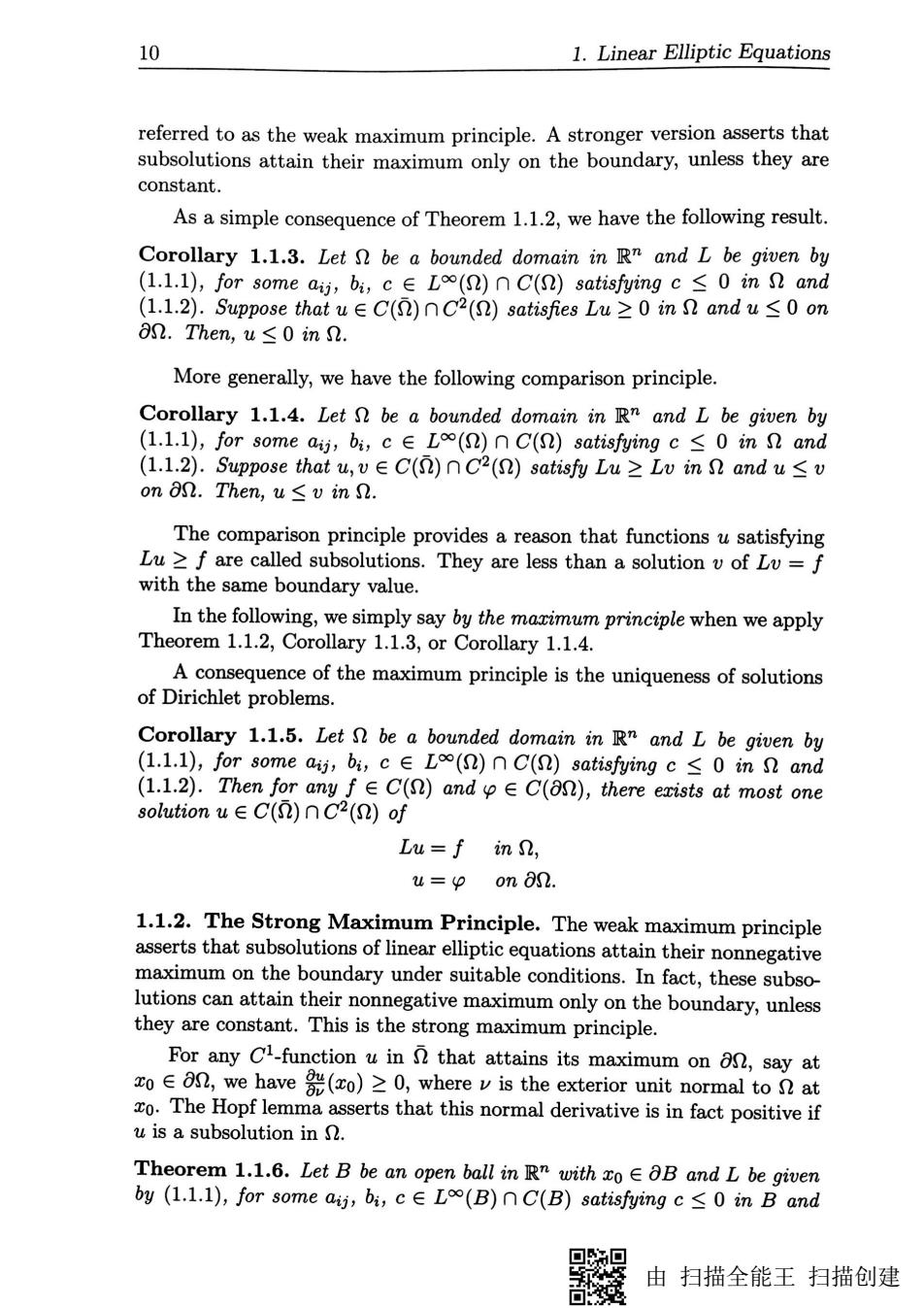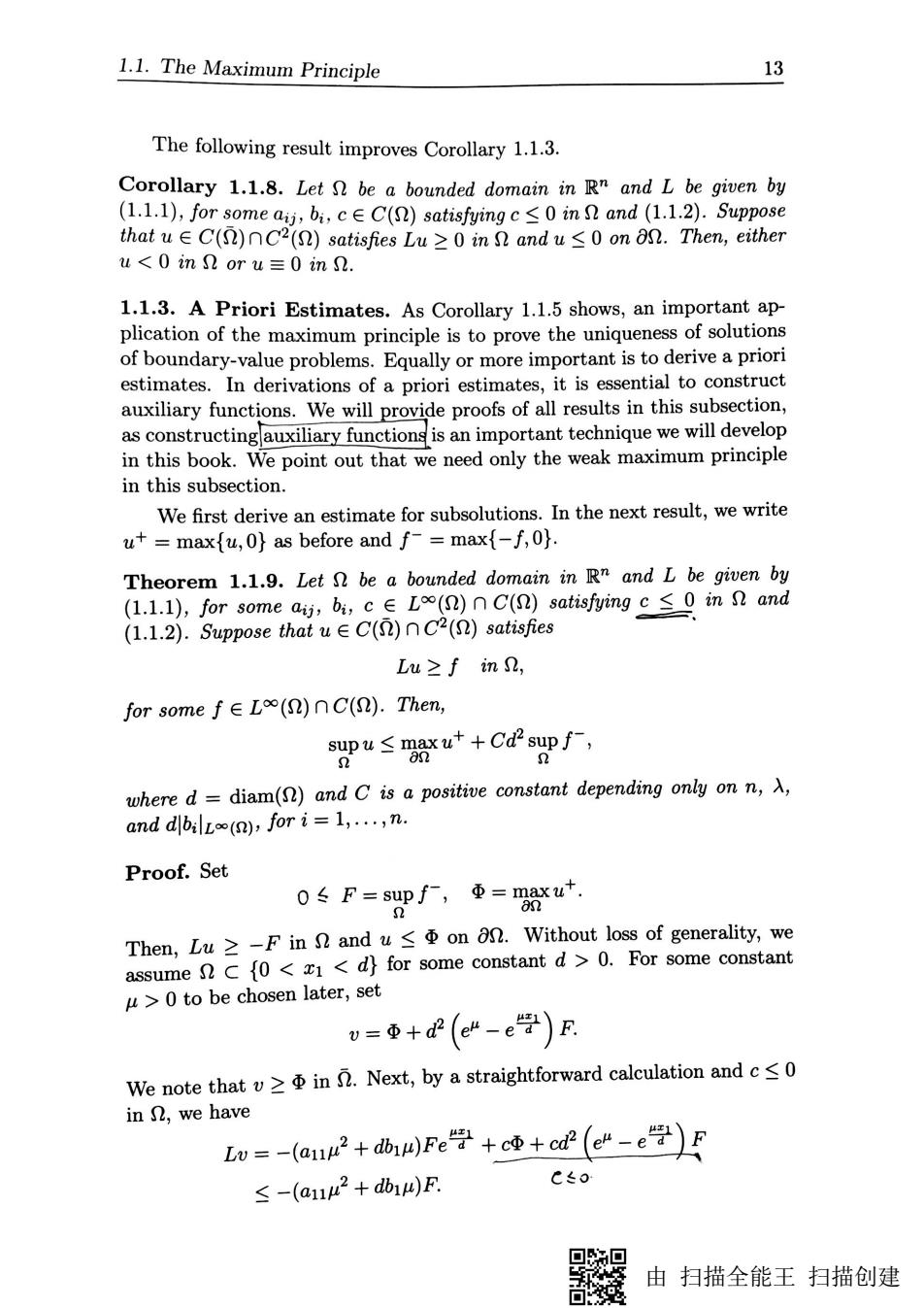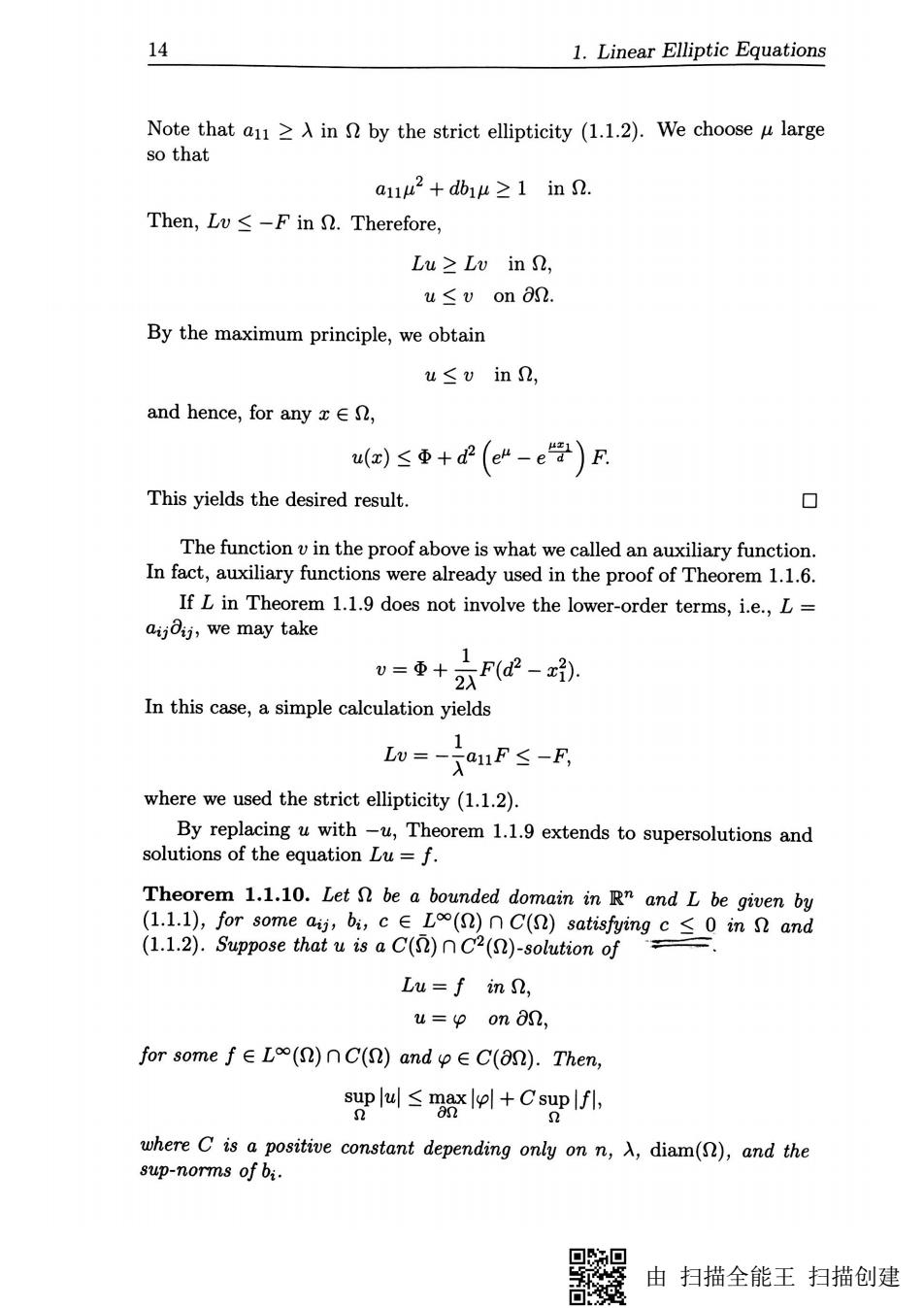
Chapter 1 Linear Elliptic Equations In this chapter, we review briefly three basic topics in the theory of lin- ear elliptic equations: the maximum principle, Krylov-Safonov's Harnack inequality, and the Schauder theory. In Section 1.1, we review Hopf's maximum principle. The maximum principle is an important method to study elliptic differential equations of the second order. In this section, we review the weak maximum principle and the strong maximum principle and derive several forms of a priori estimates of solutions. In Section 1.2, we review Krylov-Safonov's Harnack inequality. The Harnack inequality is an important result in the theory of elliptic differential equations of the second order and plays a fundamental role in the study of nonlinear elliptic differential equations. In Section 1.3, we review the Schauder theory for uniformly elliptic linear equations. Three main topics are a priori estimates in Holder norms, the regularity of arbitrary solutions, and the solvability of the Dirichlet problem. Among these topics, a priori estimates are the most fundamental and form the basis for the existence and the regularity of solutions. We will review both the interior Schauder theory and the global Schauder theory. These three sections play different roles in the rest of the book. In the study of quasilinear elliptic equations in Part 1, the maximum principle will be used to derive estimates of derivatives up to the first order, the Harnack inequality will be used to derive estimates of the Holder semi- norms of derivatives of the first order, and the Schauder theory will be used 由扫描全能王扫描创建
由 扫描全能王 扫描创建

8 1.Linear Elliptic Equations to solve the linearized equations.In the study of fully nonlinear elliptic equtions n Part2,the maximum principle will be used to derive estimates of derivatives up to the second order,the Harnack inequality will be used to derive estimates of the Holder semi-norms of derivatives of the second order and the Schauder theory will be used to solve the linearized equations. It is not our intention to present a complete review of the linear theory. Notably missing from this short review are the W2.P-theory for linear equa- tions of the nondivergence form and theHtheory and the de Gorgi-Moser theory for linear equations of the divergence form.Refer to Chapters 2-9 of (59]for a complete account of the linear theory. 1.1.The Maximum Principle The maximun principle is an important method to study elliptic differential equtions of the second order.In,we review the weak maximum principle and the strong maximum principle and derive several forms of a priori estimates of solutions.Refer to Chapter 3 of [59]for details. Throughout this section,we let be a bounded domain in Rn and let eeaicen7waenaenaa融y-od (1.1.1) Lu aijdiju+bidiu+cu in s, for any uC2().The operator L is always assumed to be strictly elliptic in;namely,for any x∈nandξ∈Rm, (1.1.2) a4(x)5≥A|2, for some positive constant.For later reference,Lis callednformlyelliptic if,for any x∈nandξ∈R", (1.1.3) A52≤a(x)5i≤A512, for some positive constants A and A,which are usually called the ellipticity constants. 1.1.1.The Weak Maximum Principle.In this subsection, we review the weak maximum principle and its corollaries.We first introduce subso lutions and supersolutions. Definition 1.1.1.For some f C(),a C2()-function u is called a sub solution (or supersolution)of Lw f if Lu f (or Lu f)in S. If aij =6ij,bi=c=0,and f=0,subsolutions (or supersolutions)are subharmonic (or superharmonic) Now we prove the weak maximum principle for subsolutions.Recall that u+is the nonnegative part of u,defined by ut=maxto,u. 由扫描全能王扫描创建
由 扫描全能王 扫描创建

1.1.The Maximum Principle 9 Theorem 1.1.2.Let be a bounded domain in R"and L be given by (1.1,for somei(()satisfving i and (1.1.2).Suppose that C()()satisfies Lu0 in Then,u attains onon its nonnegative marimum in S;i.e., mgxw≤xu+, Proof.We first consider the special case Lu >0 in If u has a local nonnegative maximum at a point o in then u(o)0,Vu(o)=0, and the Hessian matrix ((is negative semi-definite.By (1.1.),the matrix (a(xo))is positive definite.Then, Lu(xo)=(aaju+b:8,u+cu)(xo)≤0. This leads to a contradiction.Hence,the nonnegative maximum of u in is attained only on on. Now we consider the general case Lu>0 in For any e>0,consider w(z)=u(x)+Eeu=i, where uis a positive constant to be determined.Then, Lw=Lu se"i (anlu2+bu+c). Since b1 and c are bounded and a1 >A>0 in by choosing >0 large enough,we get a1142+b14+c>0in2 This implies Lw>0 in By the special case we just discussed,w attains its nonnegative maximum only on on and hence, xw≤器w+ Then mgxu≤mxw≤rxw+≤器xw+exe We have the desired result by letting e0 and using the fact that on c. 0 If c=0 in we can draw conclusions about the maximum of u rather than its nonnegative maximum.A similar remark holds for the strong max- imum principle. A continuous function in always attains its maximum in D.Theorem 1.1.2aserts that any subo upto the boundary attainsits maximum on the boundary an,but possibly also in Theorem 1.1.2 is 由扫描全能王扫描创建 ▣
由 扫描全能王 扫描创建

10 1.Linear Elliptic Equations referred to as the weak maximum principle.A stronger version asserts that subsolutions attain their maximum only on the boundary,unless they are constant. As a simple consequence of Theorem 1.1.2,we have the following result Corollary 1.1.3.Let be a bounded domain in Rm and L be given by (1.1,for some a,b,c∈L()nC(2)satisfying c≤0nand (1.l.2).Suppose that u∈C()nC2()satisfies Lu≥0 in and u≤0on an.Then,u≤0inn. More generally,we have the following comparison principle. Corollary 1.1.4.Let be a bounded domain in R and L be given by (1.l.1),for some aij,b,c∈L(2)nC()satisfying c≤0 in n and (1.1.2).Suppose that u,v∈C(①)nC2()satisfy Lu≥Lv in and u<u onan.Then,u≤vinn. The comparison principle provides a reason that functions u satisfying Lu≥fare alled subsolutions.They are less than a solution v of Lv=f with the same boundary value. In the following,we simply say by the maximum principle when we apply Theorem 1.1.2,Corollary 1.1.3,or Corollary 1.1.4. A consequence of the maximum principle is the uniqueness of solutions of Dirichlet problems. Corollary 1.1.5.Let S be a bounded dom ain in Rn and L be given by (1.1.1),for some a4j,bi,c∈L∞()nC()satisfying c≤0 in and (1.1.2).Then for any fC()and C(8s),there exists at most one solution uEC()nC2(S)of Lu=f in, u=on 8n. 1.1.2.The Strong Maximum Principle.The weak maximum principle asserts that subsolutions of linear elliptic equations attain their nonnegative maximum on the boundary under suitable conditions.In fact,these subso- lutions can attain their nonnegative maximum only on the boundary,unless they are constant.This is the strong maximum principle. For any Cl-function u in that attains its maximum on 80,say at zoas,we have(o)20,where v is the exterior unit normal to at zo.The Hopf lemma asserts that this normal derivative is in fact positive if u is a subsolution in Theore m 1.1.6.Let B be an open ball in R"with o EB and L be given by (1.1.1),for some aij,bi,c L(B)nC(B)satisfying c<0 in B and 由扫描全能王扫描创建
由 扫描全能王 扫描创建

1.1.The Maximum Principle 11 (1.1.2).Suppose that uC(B)C2(B)satisfies LuinB,u(0, where v is the exterior unit normal to B at xo. Proof.Without los of generality,we assume B=Bg for someR.By the continuity of u up to aBr,we have,for any BR, u(x)≤u(xo) For positive constants u and e to be determined,we set w(z)=e-ulzP2-e-uR2 and v(z)=u(z)-u(xo)+Ew(x). We consider w and v in D=BR\BR/2. A direct calculation yields Lw =e[4uazj-2uaijg-2b+c)-ce-R ≥e4e{4u2ax)-2μ(a6+biz)+c, where we used c in BR.By the strict ellipticity (1.1.2),we have a,ez≥AzP≥AR2inD Hence, Luw≥e4eP{u2R2-2u(a46+bz)+c}≥0inD if we chooseμsufficiently large.Byc≤0andu(xo)≥O,we obtain,for any e>0, Lv=Lu+eLw -cu(xo)0 in D. Next,we discussvon in two cases.First,on we have u(0,by the continuity of u on Bg/2. Note that w0 in D andv0 on OD.By the maximum principle, we have v≤0inD 由扫描全能王扫描创建 ▣
由 扫描全能王 扫描创建

e 1.Linear Elliptic Equntions In view of (ro)=0,v attains at ro its maximum in D.Hence,we obtain mnl≥. and then 0w2- ()=2cpRe-e>0. This is the desired result. ◇ Theorem 1.1.6still holds if we for Bany bounded domain which satisfies an interior sphere condition at roea,namely,if there exists a ball B C with ro E B.This is because such a ball B is tangent to on at ro.We note that the interior sphere condition always holds for C2-domains. Now,we are ready to prove the strong maximum principle due to Hopf 8 Theorem 1.1.7.Let be a bounded domain in R"and L be given by (1.1.1),for some bcC(S)satisfvingein and (11.2).Suppose that u E C()C2()satisfies Lu 20 in S.Then,u attains only on 89 its nonnegative marimum in S unless u is constant. Proof.Let M be the nonnegative maximum of u in and set D={x∈2:u(x)=M}. We prove either D=0or D=by contradiction.Suppose D is a nonempty relat: ve such that oBnD0.In fact,we may choose a point z.\D with dist(.D)0 where v is the exterior unit normal to B at to.On the other hand,xo is an interior maximum point of u in This implies Vu(xo)=0,which leads to a contradiction.Therefore,either D=0 or D=.In the first case,u attains only on on its nonnegative maximum in while in the second case, u is constant in s. □ 由扫描全能王扫描创建
由 扫描全能王 扫描创建

1.1.The Maximum Principle 13 The following result improves Corollary 1.1.3. Corollary 1.1.8.Let be a bounded domain in R"and L be given by (1.1.1),for some aii,bi.cC(S)satisfuingc0.For some constant >0to be chosen later,set u=Φ+d(e-e学)F We note that v≥ΦinD.Next,by a straightforward calculation and c≤0 in we have Lw=-(ar2+db)Fe学+c中+a(e-e学)F ≤-(a1142+db1)F cso g 由扫描全能王扫描创建 ▣
由 扫描全能王 扫描创建

14 1.Linear Elliptic Equations Note that a1l≥入in2 by the strict ellipticity(1.l.2).We chooseμlarge so that a1142+db14≥1in2. Then,Lv <-F in Therefore, Lu≥Lv in S, u≤vona2 By the maximum principle,we obtain u≤vin2, and hence,for any x∈n, u()≤电+d(e-e学)r This yields the desired result. ◇ The the proof above is what we called an auxiliary function In fact,auxiliary functions were already used in the proof of Theorem 1.1.6. If L in Theorem 1.1.9 does not involve the lower-order terms,i.e.,L= aijoij,we may take =+2F2- In this case,a simple calculation yields Lw=-a1F≤-R where we used the strict ellipticity(1.1.2). By replacing u with-u,Theorem 1.1.9 extends to supersolutions and solutions of the equation Lu=f. Theorem 1.1.10.Let be a bounded domain in Rn and L be given by (1),for some)satising i and (1.1.2).Suppose that u is a C()2()-solution of Lu=f in, u=y on 8n, for some f∈L()nC()andp∈C(an).Then, sP叫≤2xlol+CsupIfl, where C is a positive constant depending only on n,A,diam(),and the sup-norms of bi. 由扫描全能王扫描创建
由 扫描全能王 扫描创建

1.1.The Maximum Principle 15 Next,we construct barrier functions for a large class of domains and erties of s tant role.We con erterior sphere condition atin the sese that there existsaball B()such that nBR(yo)=0,nBR(yo)={zo}. Lemma 1.1.11.Let be a bounded domain in R"satisfying an exterior sphere condition ato and L be given by(1.1.1),for some,bi, c()(1.1.3).Then,there exists a function wo EC()nC-(S)such that Lwxo≤-1inD and,for any x∈n\{xo}, 0xo(xo)=0,wxo(x)>0, where wo depends only on n,A,A,the Lo-norms of bi,diam(),and R in the exterior sphere condition. Proof.Set D-diam().For the given,conider an exterior ball BR(y)with BR(y)n={ro}.Let d(z)be the distance from x to aBR(y); i.e., d()=l-yl-R.s dot (xK)diam Then,for any x∈, 00 in (D).Set w=(d)in S. We now calculate Lw.A direct calculation yields ad6-- axd()= z-3 Hence,IVdl=1,aijoidojd >A,and 1 1 doyd 六会司 nA 入 R Next, 8w='id,8ijw="8idojd+ijd. Then, Lw =v"aijoidojd+(aijdiid+bidid)+co. 用别c。 47o 由扫描全能王扫描创建 ▣
由 扫描全能王 扫描创建

16 1.Linear Elliptic Equations We now require>0 and "0in(0,D),and(o)=0. First,general solutions of the ordinary differential equation above are given by 表尺叭是匠 (④=-8d+C-gea4 a 帝? for some constants Ci and C2.For (0)=0,we need C1=C2/a.Hence we have,for some constant C. =-a+-e, a which implies v@=cew-&=e(c-&) "(d)=-Cae-ad. In order to have i D),we need C Then,i (0,D),and hence()=0 in (0,D).Therefore,we take 网=-2+总0ce01-6叫 平祖式美光然风花 -8a-6- Such a satisfies all the requirements we imposed. Now we estimate the modulus of continuity of solutions with the help of barrier functions constructed in Lemma 1.1.11. 由扫描全能王扫描创建
由 扫描全能王 扫描创建